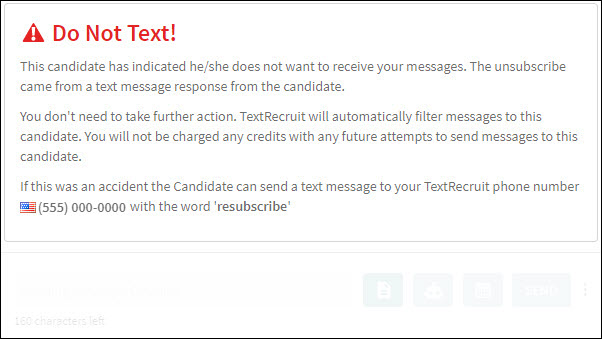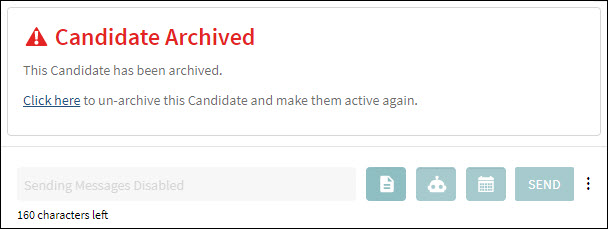Overview
iCIMS Text Engagement users can take a number of actions to help organize candidates and ensure that the right people are contacted at the right time. This article describes the actions available from candidate profiles and candidate conversations in the inbox.
Note: Candidates must be added to Text Engagement before users can access their profiles for these actions. For information on adding candidates, review the iCIMS Text Engagement: Adding Candidates article.
Using Candidate Profile Actions
This section outlines the actions available from the Actions dropdown on the candidate profile and candidate conversation view in the inbox.

- Add to a Tag: Clicking this action directs users to the Tags section of the Candidate profile where they can enter a tag name to add to the profile. For more information on candidate tags, review the iCIMS Text Engagement: Adding and Managing Tags article.
- Note: In the inbox view, this action is named Edit Tags.
-
Star Candidate: Clicking this action stars the candidate, indicated by a yellow star on the candidate profile. Candidates that are starred display in a list on the Starred Candidates page, available via the Starred tab on the left sidebar.
-
Edit Candidate: Clicking this action launches the Edit Candidate popup. Users can edit the candidate First Name, Last Name, Cell #, and Job Title fields from this popup.
-
Validate Phone Number: Clicking this action validates the candidate’s phone number. A validating message briefly displays in the upper left corner of the profile. Then, the carrier name and a green check box displays next to the phone number, if valid.
-
Add a Campaign: Clicking this action launches the Add Campaign popup. Users can search for and select a campaign to add the candidate to, or they can add a new campaign from this popup. For more information on campaigns, review the iCIMS Text Engagement: Creating a Campaign article.
-
Save Candidate Data (PDF): Clicking this action downloads a GDPR Export file with candidate data in PDF format, including general candidate information (e.g., full name, phone number) and their message history. This action is usually taken when users receive a data access request to send this information to the candidate.
-
Mark ‘Do Not Text’: Caution is advised when using this action. Clicking this action marks the candidate as Do Not Text and prevents all messages from being sent to the candidate profile. Once applied, this action can only be reverted by having the candidate text the word resubscribe to a user from the phone number listed on their candidate profile.
- Note: If a candidate has been marked as Do Not Text, a message displays on their profile alerting users that messaging has been disabled for the candidate. This message also displays if a candidate has opted out of texts by sending a user a message like STOP.

- Mark Inactive: Clicking this action marks a candidate as inactive which disables users’ ability to message them. (A confirmation popup first displays to ensure the candidate should be marked inactive.) Once a candidate has been marked inactive, this action is renamed Mark Active; clicking Mark Active reactivates the candidate and allows users to resume their messaging.

-
Notes:
- Inactive candidates still display in the Candidates list and their conversation history remains in users’ inboxes; however, a gray Inactive label displays in both areas to indicate that they are inactive.
- While inactive candidates cannot receive messages, they can still reply to users; any messages sent by the candidate will continue to display in users’ inboxes.
- Tip: The Mark Inactive action can be used to temporarily prevent candidates from receiving messages, while remaining visible in the Candidates list for future activity. This can be helpful for organizations to keep candidates on their radar who may not be eligible for hire yet but should be considered for future openings (e.g., seasonal hires).
- Archive Candidate: Clicking this action archives a candidate which disables users’ ability to message them and removes their name from the Candidates list. (A confirmation popup first displays to ensure the candidate should be archived.) Once a candidate has been archived, this action is renamed Un-Archive Candidate; clicking Un-Archive Candidate allows users to resume their messaging and adds the candidate back to the Candidates list.

-
Notes:
- Archived candidates’ conversation history remains in the inbox with a red Archived label indicating that they are archived.
- Archived candidates cannot reply to users, and any messages sent by the candidate while they are archived will not display in users’ inboxes or their conversation history.
- Tip: The Archive Candidate action can be used when a candidate should no longer be in contact with your organization (e.g., if they had used vulgar language with a recruiter during the interview).
Note: If you are a Text Engagement admin interested in permanently deleting candidates from the Text Engagement system, refer to the iCIMS Text Engagement: Purging Candidates article.




